| |
|
|
| |
Mira Mar Veterinary Hospital
|
|
| |
|
|
| |
|
|
| |
|
|
|
|
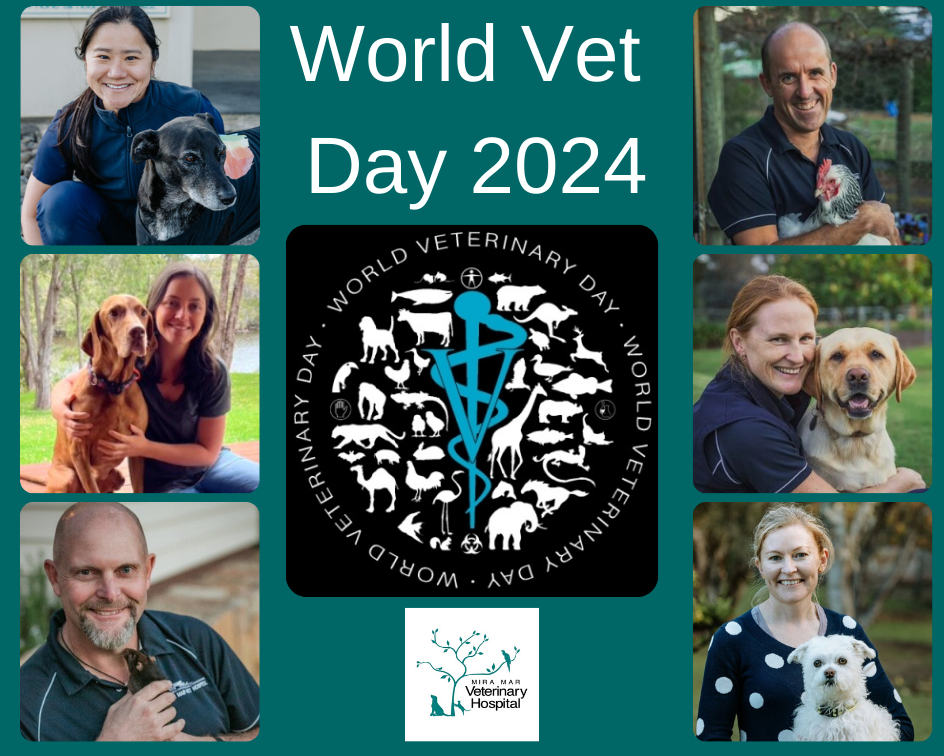
|
| |
May Newsletter
|
|
| |
|
|
| |
Hello and welcome to our May Newsletter!
We recognised World Veterinary Day on the last Saturday in April, a celebration of the role vets play in our lives! This year's theme, "Veterinarians are essential health workers", highlights the vital contributions that vets make to the physical, mental, and social well-being of people through the care of pets and livestock.
We see this every day at Mira Mar Vets, where we know our patients are our priority, but their people play a very important part too!
So, THANK YOU to our exceptionally caring and hard-working vets, and happy World Vet Day to all the other amazing vets out there!
|
|
|
|

|
| |
Mira Mar Vets are hiring!
|
|
| |
|
|
| |
We are looking for another qualified veterinary nurse to join our fabulous team. Please visit our website for more information www.miramarvet.com.au/employment/ and send any applications via email to admin@miramarvet .com.au |
|
| |
|
|
| |
Find out more
|
|
|
|
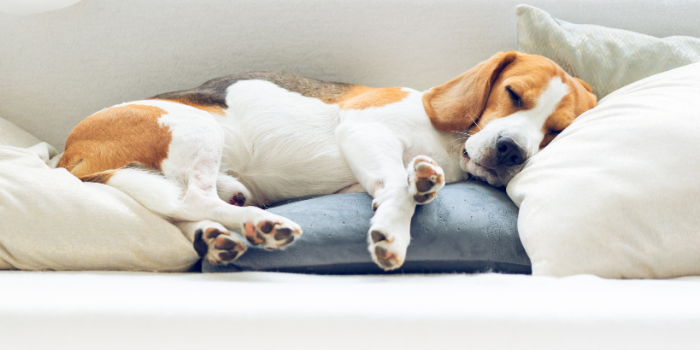
|
| |
What is pet resuscitation?
|
|
| |
|
|
| |
If your pet ever suffers a serious illness or injury, you may have to consent to veterinary resuscitation procedures being performed on them. This can understandably feel overwhelming, particularly during an already stressful and upsetting situation.
We’d therefore like to discuss what pet resuscitation actually involves in the hope that, should you ever be in such a situation with your pet, you can feel more informed and comfortable to quickly make the best decisions for your pet and your family.
What is resuscitation?
Pet resuscitation can involve a variety of medical interventions, which may be performed separately or in combination, depending on the condition of that pet.
The first step of resuscitation is always a rapid assessment of the pet to assess its most basic functions: airway, breathing, and circulatory (blood flow) status.
Depending on the pet’s condition, we may then recommend:
- Fluid resuscitation: this involves the rapid administration of calculated amounts of medical fluids into your pet’s vein, to help boost their blood volume and circulatory flow
- Basic life support: this involves ensuring your pet’s main airway is clear (which may involve the placement of a breathing tube), and assistance with their circulation and breathing through chest compressions and manual ventilation (giving them breaths, usually via an anaesthetic machine and fresh oxygen flow)
- Advanced life support: this involves more advanced measures such as administering adrenalin into your pet’s vein (which can help to stimulate their heart and lung function) and monitoring their heart rhythm with an ECG machine
What can you do to help?
Whilst it’s a distressing scenario to have to consider, it really helps if you (and your family, if relevant) have previously discussed and agreed on how much medical intervention you would like your pet to receive in an emergency.
If you are unsure or would like more information on pet emergency care, please have a chat with our compassionate team. |
|
|
|
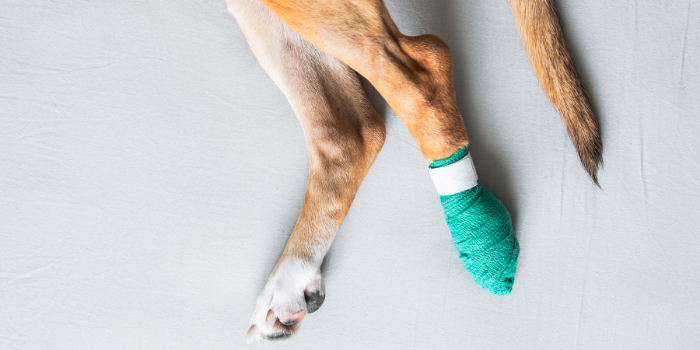
|
| |
That’s a wrap on bandaging support
|
|
| |
|
|
| |
If applied incorrectly, bandages can actually cause harm to your pet. Here are our team’s top tips on how to apply a safe and effective dressing.
When might a bandage be required for your pet?
In general, it’s best to bring your pet to the clinic for a prompt veterinary assessment of any significant injuries, rather than trying to manage them yourself. This is especially necessary if your pet has any steady bleeding, appears to have a broken limb, or is showing symptoms of pain or lethargy.
However, if your pet has a wound but otherwise seems OK and you can’t bring them in to see us for more than a couple of hours, applying a light protective dressing can help prevent wound contamination.
What supplies might you need?
If you want to prepare a home bandaging kit for your pet, we’d recommend purchasing the following supplies from a human pharmacy:
- Sterile, non-stick, absorptive wound pads (such as Allevyn)
- A few rolls of crepe bandage (for gentle to moderate compression)
- A few rolls of conforming bandage (for stronger support of high-motion areas)
- Adhesive bandage tape
- Bottles of sterile saline
- Sterile cotton swabs
How should a bandage be applied?
Firstly, if your pet will let you, gently flush wounds clean with sterile saline, pat the area around the wound and dry with a sterile cotton swab.
Then place a sterile wound pad against the site and apply an appropriate bandage over the top for extra support, with tape to secure it. Here is a video demonstrating the application of a paw bandage (using alternate materials).
What are some common bandaging mistakes to avoid?
Avoid:
- Applying bandages too tightly – you should be able to fit at least one finger underneath limb bandages
- Allowing bandages to get wet or dirty, which can trigger infection of the wound or surrounding skin
For more tips on bandaging like a boss, consult our first aid proficient team. |
|
|
|
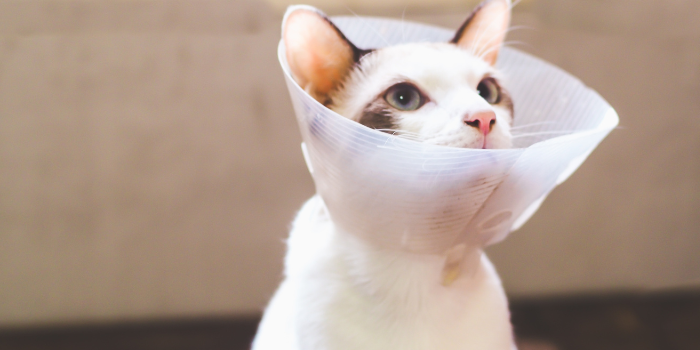
|
| |
The don’ts of desexing
|
|
| |
|
|
| |
Whilst we often consider desexing operations to be “routine” in pets, it’s important to remember that they are still a surgical procedure (and a particularly significant one in the case of female pets!), and potentially serious complications can sometimes occur.
Whilst we always do our best to minimise the chances of surgical or anaesthetic issues while your pet is in the hospital, it’s just as vital that you stick to the recommended aftercare instructions to help ensure your pet has a smooth recovery.
Here are two of the most common post-desexing complications, and how you can help to prevent them:
1. Wound infection
Desexing wound infections are uncommon but are much more likely to occur if your pet has been allowed to lick at their operation site.
Ensure that your pet does not lick its wound by consistently using an Elizabethan (bucket) collar, a properly fitted inflatable collar, or (in the case of female cats) a snugly fitting body suit.
If you notice any increased redness or discharge from your pet’s wound, bringing them back for a check as promptly as possible is essential.
2. Excessive wound swelling and/or pain
Imagine if we had a major abdominal or “downstairs” surgery and then went running a few days later? We’d likely experience significant pain and swelling, and our unhealed wound could even rip open (ouch!).
It’s important to keep your pet confined and rested (except for short, on-lead toileting walks in the case of dogs) for 10-14 days post-operatively to help their wound heal as smoothly and comfortably as possible. If your pet is very active, ask us about post-operative sedation options.
If you notice any significant swelling, lumpiness, or other changes at your pet’s surgical site, it’s best to bring them back as promptly as possible for a recheck with our experienced team.
As they say, a stitch in time saves nine! |
|
|
|
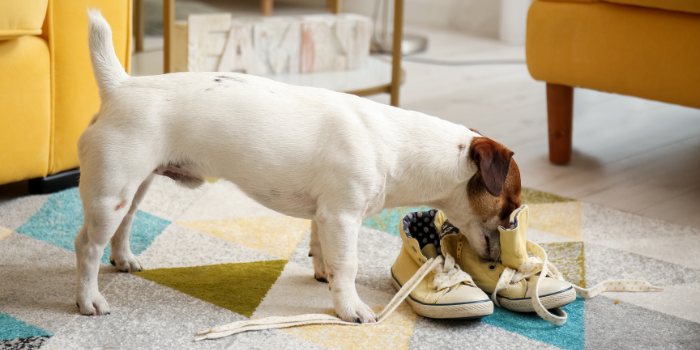
|
| |
What did you just eat?! Essential actions for pets' unplanned snacks
|
|
| |
|
|
| |
If your pet has just been caught "red-pawed" raiding the bin, pantry, shed, or medicine cabinet, it's important to act quickly to help reduce potential harm.
Here's what to do and what not to do if your pet has eaten something silly.
What to do:
1. Be aware of the more common household dangers
Common household toxins for pets include:
- Food items such as chocolate, cacao, raisins, grapes, onions, garlic, and foods containing xylitol sweeteners
- Rotting garbage
- Toxic plants such as lilies or sago palm
- Some essential oils (particularly undiluted), such as tea tree oil
- Human medications such as paracetamol, ibuprofen, and anti-depressants
- Chemicals such as rat bait, snail bait, weedkiller, and cleaning products
- Small objects such as batteries
2. Detective work
Quickly try to ascertain exactly what your pet has eaten. This involves confirming what substances they might have eaten (get a brand name and/or active ingredient if you can) and the approximate quantity.
3. Seek veterinary advice
As soon as possible, phone our experienced team to ask for advice. If you can't reach us, you can also seek advice from the Animal Poisons Helpline.
Even if you're not sure whether what your pet consumed is likely to be harmful or not, it's always safest to check.
What not to do
1. Watch and wait without veterinary advice
Prompt veterinary treatment can mean the difference between a near miss and a fatal poisoning for your pet.
If your pet has ingested a toxin within the last 1-4 hours, we may be able to induce vomiting to clear their system of the toxin. In other cases, we can administer appropriate antidotes or supportive therapy to minimise their symptoms.
2. Try to treat your pet yourself
Don't be tempted to try home remedies from Google. Unfortunately, we have seen pets present unwell due to inappropriate substances administered by well-meaning owners. Prompt veterinary assessment is always best!
For more advice on dietary indiscretion in pets, consult our toxicology-talented team! |
|
|
|
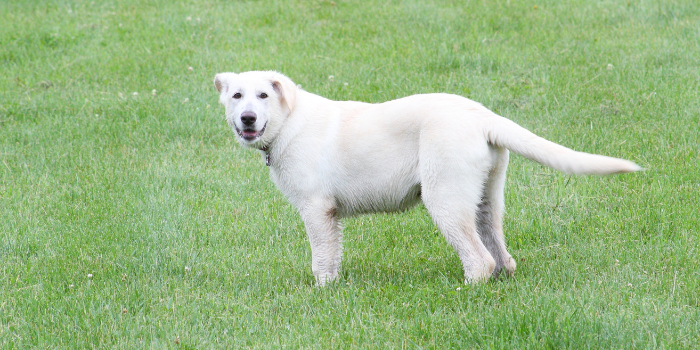
|
| |
Larry’s been too happy: The unexpected downsides of a wagging tail
|
|
| |
|
|
| |
Larry the labrador and his owner Otis had enjoyed a big autumn weekend at the family farm. As usual, Larry had the time of his life trying to keep up with the two working kelpies and then paddling happily around in the river afterwards.
The next day, however, Larry wasn’t so cheery. The dog seemed subdued and reluctant to move out of his bed. When Otis offered him breakfast (which usually fixed any issue for Larry), Larry yelped and cowered down.
Remembering that labradors are prone to joint issues like hip dysplasia, Otis phoned his local veterinary hospital to ask for advice. Given Larry seemed so out of sorts, the nurse recommended booking the dog in for a veterinary assessment later that morning.
At the appointment, the vet performed a thorough physical examination of Larry. Whilst Larry seemed very reluctant to be touched around his back end, he showed no signs of limping, and had a normal range of motion in all his joints. The vet did notice, however, that Larry seemed to be holding his tail down very low, as opposed to his usual constant wag.
On gentle palpation of the area around his tail base, Larry yelped and jumped away. Given the dog hadn’t suffered any obvious trauma in this area, the vet diagnosed him with likely Limber tail syndrome (LTS). LTS is a condition seen mostly in hunting dogs, involving acute swelling and pain in the tail-base region. It usually occurs due to overexertion of the tail, particularly in colder conditions.
TL;DR: Larry had wagged too much!
Larry was prescribed a course of anti-inflammatory pain relief, and a period of rest and restricted exercise. Within five days, he seemed back to normal, as indicated by the return of his usual vigorous wag and wiggle (despite Otis’s attempts to enforce rest).
If your pet shows any signs of sudden pain or lameness, please don’t hesitate to consult our helpful team. Like Larry, we’re always happy to help! |
|
|
|
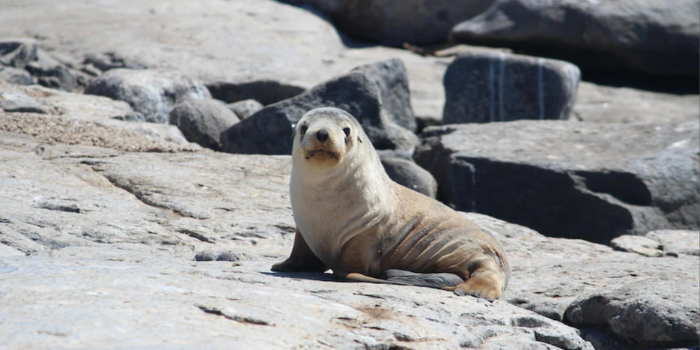
|
| |
Call to expand sanctuary zones for sea lion protection sparks debate
|
|
| |
|
|
| |
Environmental advocates are urging for an increase in sanctuary zones within the newly proposed South Coast Marine Park in Western Australia to safeguard the Australian sea lion, the country's most endangered seal species. Christabel Mitchell from Pew Charitable Trusts emphasises the necessity of these protections, highlighting that "certain key breeding sites critical to their survival are missing protection." The decline of sea lion populations by over 60% in the last 40 years signals an urgent need for action.
Conversely, the fishing industry, represented by Darryl Hockey of the WA Fishing Industry Council, asserts that comprehensive protection measures are already in place and cautions against the economic impacts of further restrictions. The industry points to existing gillnet exclusion zones and the introduction of Sea Lion Exclusion Devices as effective steps already taken to mitigate risks to sea lions.
The debate extends to other marine life, with both sides acknowledging the importance of sanctuary zones for endangered southern right whales. However, concerns have been raised about the proposed management plans' effectiveness and the scientific basis of the sanctuary zones. Despite these controversies, officials maintain that the proposed zones aim to protect critical habitats for sea lions and whales, reflecting a balance between conservation needs and fishing activities.
Click here to read the ABC's full story.
Photo credit: National Parks and Wildlife Service South Australia |
|
|
|
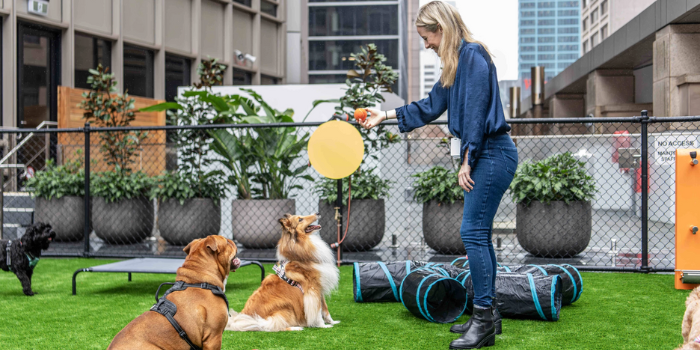
|
| |
Animal News In Brief
|
|
| |
|
|
| |
Amazon's Sydney office unveils dog playground
With 69% of Aussie dog owners saying they want to bring their pets to the office, Amazon Australia has unveiled a dog playground at its Sydney office, responding to the desires of its pet-owning employees. Designed to enhance the work-life balance, this innovative space underlines Amazon's commitment to creating a pet-friendly environment. Georgia Mitchell, Amazon Australia's senior manager of Workplace Experience, emphasises, "Dogs at work have positive impacts on productivity, innovation, and collaboration, all of which we are focused on enhancing through the workplace experiences we create." The initiative has received positive feedback from local officials, recognising the mental and physical health benefits of integrating pets into everyday environments.
Click here to read the full story on Amazon Australia.
Photo Credit: Amazon Australia
Private dog parks: a new suburban side hustle
Homeowners are renting out their backyards as private dog parks, a creative way to earn extra income. Leasa Gill, who initiated this in Queensland, saw it as an opportunity to provide a safe play space for dogs, addressing the concerns of dog owners like Samantha Leach. Leach finds the private park perfect for her sensitive kelpie, Jack, avoiding the stress of public dog parks. "He just gets to be himself," Leach says, appreciating the private, stress-free environment. However, Bond University’s Tammy Johnson cautions about the legalities and insurance issues involved, emphasising the importance of understanding the potential risks before diving into this venture.
Click here to read the full story at ABC News.
Fascinating insights into Australian cat ownership
Recent research showed that Australia's love for cats is evident, with recent statistics showing 33% of households have at least one cat, totalling an estimated 5.3 million pet cats nationwide. "Pets have positively impacted 85% of Australian lives," highlighting the important role cats play in many households. The research also sheds light on the impact of the COVID-19 pandemic on pet ownership, with a notable increase in cat adoptions. However, the presence of feral cats remains a significant environmental concern, with these animals contributing to the extinction of 22 native mammal species. The statistics provide a comprehensive look into the complexities of cat ownership in Australia.
Click here to see more interesting Australian cat ownership insights at Catster. |
|
|
|
| |
This email contains comments of a general nature only and is not intended to be a substitute for professional veterinary advice. It should not be relied on as the basis for whether you do or don't do anything.
All content © PetPack 2023 |
|
|
|
[Footer]
|